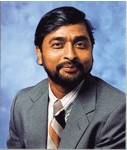

Interview with Ammasi Periasamy

Professor Ammasi Periasamy is a Professor at the University of Virginia and the Center Director for W.M. Keck Center for Cellular Imaging. Periasamy is an internationally recognized expert in advanced microscopy techniques, particularly in the area of molecular imaging in living cells and tissue using FRET.
IDEX Health & Science: You have made significant transitions during your career. For example, you started with a degree in Physics from India, yet currently you are a Professor of Biology in the US. Would you like to share your journey through different disciplines as well as geographical moves?
Ammasi Periasamy: Yes, it is a long road. While I was studying math, physics, and chemistry during my pre-university at Kandaswamy Kandar College, located in Tamil Nadu, one of my teachers, Dr. Masilamani, encouraged me to pursue a degree in Physics since I was always good in mathematics. I pursued his suggestion and received my undergraduate degree in Physics from the same college, and later my masters in Physics at Annamalai University with specialization in Optics and Spectroscopy. During the masters degree I used to tell my friends that one day I wanted to become a scientist. My interest was primarily in applications utilizing physics rather than investigating basic physics. Therefore, I joined Indian Institute of Technology, Madras, and obtained my second masters degree in Biomedical Engineering with emphasis in the area of muscle physiology using optics and laser interferometry techniques. I continued this work on the clinical side to monitor heart diseases.
While I was writing my Ph.D. thesis I was employed by the Anna University at Madras (previously it was called the famous and historic Guindy engineering college) as Assistant Professor, and participated in the development of a curriculum in Medical Physics and Laser technology. I never expected that I would be working in the USA. It so happened that after a stay of about 2 years at the Anna university, I received an offer for a postdoctoral position from University of Washington, Seattle to work in the area of muscle physiology. During my postdoctoral work, I developed a polarization microscopy technique to investigate the muscle fiber contraction, and this work was published in the Biophysical journal. During my postdoctoral period, I got interested in the development of microscopy techniques for biological and clinical applications.
After my postdoc, I briefly stayed at Medical University of South Carolina, Charleston, before accepting an offer at the University of North Carolina, Chapel Hill, where I developed a fluorescence lifetime imaging system using a gating camera provided by Hamamatsu to measure intracellular calcium. It was a great experience and I learned how to implement a new technology for biological investigations.
When I took up my present job to create a university wide imaging center at the University of Virginia, I focused my attention in the area of Förster resonance energy transfer (FRET) microscopy. My Physics background and the technology development experience from my past gave me great strength to develop the Keck Center for Cellular Imaging as one of the leading centers in the area molecular imaging using advanced light microscopy techniques.
IDEX Health & Science: You are well known for your contribution on FRET (popularly referred as Fluorescence Resonance Energy Transfer) and related methods. Where is the application of FRET headed in the future? Is FRET going to be limited to fundamental research or could it transition into clinical applications?
Ammasi Periasamy: Currently, Förster resonance energy transfer (FRET) is used in almost all areas of research. We are also working on implementing in vivo FRET imaging and on clinical applications. Essentially, we are interested in investigating cancer at the molecular level using FRET.
IDEX Health & Science: What is your advice for someone who is new to FRET and wants to use it for their research?
Ammasi Periasamy: It is important to understand the physics of FRET. Once you understand the basics of FRET, it may not be that difficult to catch up other details to connect to the biological investigation. If you are completely new, then you should consider getting trained in the FRET workshop organized by the Keck Center for Cellular Imaging at the University of Virginia. This is a hands-on training workshop.
IDEX Health & Science: FRET can be studied using intensity based measurements or by the measurement of fluorescence lifetime. Which of these FRET methods is more popular and why?
Ammasi Periasamy: The digital imaging or video imaging approach has been used successfully for over 25 years and has been applied to various biological applications. In the past, ratio FRET imaging has been used most widely. However, with the development and application of the visible fluorescent proteins, the spectral overlap can be as high as 70-90%. The higher the spectral overlap, the higher the cross-talk or contamination in the FRET signal. Such signal contamination is not desired. For quantitative analysis various mathematical algorithms have been developed to extract the FRET signal from the contamination. But, if the fluorescence lifetime (FLIM) method is used no contamination correction is required. To quantify the FRET signal you measure the donor fluorescence lifetime in the absence and the presence of the acceptor molecule. The lifetime is insensitive to the change in fluorophore concentration and the excitation intensity but it is sensitive to the environmental changes. So the FLIM method is ideal for FRET imaging.
IDEX Health & Science: Please share your thoughts on the development of FRET standards for calibration such as, for example, your (unpublished and unfinished) work with Invitrogen (Life Technologies) on the development of standard beads for FRET?
Ammasi Periasamy: The work on FRET standard beads that I was developing in collaboration with Invitrogen was discontinued a long time ago. Invitrogen does not want to continue with this development but they have made some other format of beads for FRET. Dr. Steven Vogel from NIH developed the FRET standard plasmid which you can express in any cell lines to test your microscopy system or demonstrate to students how FRET works.
IDEX Health & Science: Is there anything you can tell us about your upcoming book titled, FRET Microscopy: Critical Discussions on Image Acquisition and Analysis, Cambridge University Press, 2012 (in preparation)?
Ammasi Periasamy: Well, the FRET book which I am working on is long due. I plan to submit it to Cambridge Press during the summer of this year. In this book, I focused my writing not only on basics and various microscopy techniques, but I have also given importance to the issues involved in protein-protein interaction investigation in cells and tissues. I would like to outline for readers the various tricks involved in FRET imaging and selection of components.
